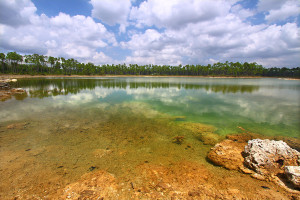 The Everglades is an internationally protected wilderness that hosts flora and fauna not found anywhere else in the world. Its diverse ecosystem weaves intricate webs of trees and marshes amid freshwater estuaries, all of which bleed into the Gulf of Mexico. There are nine habitats in the Everglades, and each plays an important role in the vitality of the area’s plants and animals. From swamps to pine forests, here’s what you can expect to find in each habitat, and which plant and wildlife can be found where:
The Everglades is an internationally protected wilderness that hosts flora and fauna not found anywhere else in the world. Its diverse ecosystem weaves intricate webs of trees and marshes amid freshwater estuaries, all of which bleed into the Gulf of Mexico. There are nine habitats in the Everglades, and each plays an important role in the vitality of the area’s plants and animals. From swamps to pine forests, here’s what you can expect to find in each habitat, and which plant and wildlife can be found where:
Freshwater slough
Sloughs are chiefly responsible for water circulation throughout the Everglades. These flooded, sunken areas of land slowly but surely distribute freshwater to other areas of the ecosystem. There are two sloughs in Everglades National Park: Taylor Slough and the larger and more-popular Shark River Slough, also known as the “River of Grass.” Both of these ensure freshwater reaches the Florida Bay. Because of their abundance of drinking water, sloughs are popular wildlife congregation sites. Visit Everglades sloughs in the dry season (November through May) for the best chance to spot alligators lounging in the sun.
Hardwood hammock
Hardwood hammocks are dry, slightly elevated concentrations of tropical and temperate trees with broad leaves. Due to their raised nature, hardwood hammock habitats don’t often flood. The trees grow close together, creating overhead canopies with shade from the sun. This allows ferns to flourish. A stroll through a hardwood hammock will expose you to the red-limbed Gumbo Limbo tree along with mahogany, oak, maple and more. Keep your eye out for the “Jewel of the Hammock,” the vibrantly colored tree snail. A natural ornament, these snails latch inconspicuously onto tree bark. Remember they’re protected, so don’t bother the little living jewels.
Pinelands
Similar to hardwood hammocks, pineland habitats grow on higher ground. Also known as Pine Rocklands, here skinny slash pine trees grow tall out of a hard limestone surface. Around the trees’ roots thrive various species of palm, from the adequately named saw palmetto to the edible sable palm. Believe it or not, pinelands rely heavily on fire for survival. Natural and human-induced brush fires strip the land, providing more space and sunlight for seeds to sprout. Over the years, pineland trees adapted to fires by acquiring thick bark and growing needles only where the fire can’t reach, toward the crown of the tree.
Coastal lowlands
This is a habitat for the most resilient flora. Found near the shore of the Gulf Coast, coastal lowlands are no stranger to severe weather, which restricts the growth of mangroves and other tall trees. Desert plants usually survive in coastal lowlands because they can withstand harsh storms without much protection. At the sandy lowlands you’ll see short, salt-tolerant shrubs like succulents. Look out for shoreline seapurslane, an herb that grows close to the ground and spreads wide across the sand. It may appear unimportant, but this succulent actually protects the shoreline from erosion by capturing sand grains in its mane, thus preserving the beach’s body.
Mangrove
The Everglades boast the most abundant population of mangroves in the entire hemisphere. Since these trees thrive where freshwater and saltwater meet, you’ll find plentiful mangrove forests sprinkled all along the coast of south Florida. These salt-tolerant mangrove trees come in three colors: red, white and black, all of which nurture plant and water life. Mangrove habitats provide essential nutrients to marine animals by depositing fallen leaves into the water. Because of the nutrient-rich water and the shelter formed by mangrove roots, many fish and crustaceans call mangrove forests their home. During low tide, you’ll often find wading birds fishing in the brackish water, thus completing the mangrove habitat food chain.
Cypress
These towering trees grow in many ways. You can find them growing in standing water or in breaks in the hard ground. When the limestone surface of a pineland habitat breaks, it gives way to “solution holes.” Often clusters of cypress trees grow inside these weathered pits, with the larger trees concentrated in the center. Dwarf cypress trees result from inadequate growing conditions, thus limiting their germination. Finally, cypress strands comprise tall, slender cypress trees in a swamp setting. Keep a look out for river otters lounging on low-lying cypress trunks. Another popular inhabitant of cypress swamps is the American Alligator.
Marine and estuarine
All eyes on Florida Bay. This is the Everglades’ largest water body, and with its space comes an abundance of aquatic life. Freshwater from Everglades estuaries mixes with salt water from the Gulf of Mexico to create the brackish conditions in Florida Bay. Towards the bottom of the bay you’ll find coral, mollusks and a plethora of gamefish. Closer to the surface, bottlenose dolphins swim in pods, loggerhead turtles coast leisurely, and West Indian Manatees float with their young. Because of the bay’s shallow depth – about three feet – wading birds capitalize on low tide fishing opportunities.
See them all
The best way to experience all nine Everglades habitats is by airboat. Captain Mitch’s Airboat Tours expose you to the Everglades’ grandeur from the safe and comfortable seats of open-space airboat. Call Captain Mitch today at 239-695-3377 or click here to schedule your Everglades adventure.






